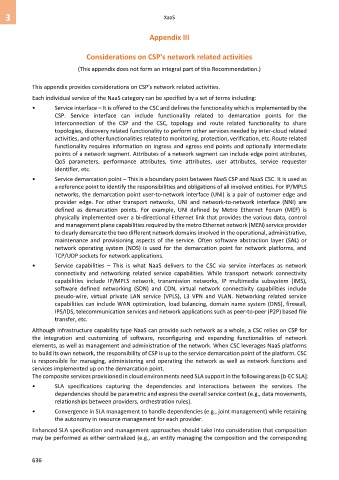Page 644 - Cloud computing: From paradigm to operation
P. 644
3 XaaS
Appendix III
Considerations on CSP's network related activities
(This appendix does not form an integral part of this Recommendation.)
This appendix provides considerations on CSP's network related activities.
Each individual service of the NaaS category can be specified by a set of terms including:
• Service interface – It is offered to the CSC and defines the functionality which is implemented by the
CSP. Service interface can include functionality related to demarcation points for the
interconnection of the CSP and the CSC, topology and route related functionality to share
topologies, discovery related functionality to perform other services needed by inter-cloud related
activities, and other functionalities related to monitoring, protection, verification, etc. Route related
functionality requires information on ingress and egress end points and optionally intermediate
points of a network segment. Attributes of a network segment can include edge point attributes,
QoS parameters, performance attributes, time attributes, user attributes, service requester
identifier, etc.
• Service demarcation point – This is a boundary point between NaaS CSP and NaaS CSC. It is used as
a reference point to identify the responsibilities and obligations of all involved entities. For IP/MPLS
networks, the demarcation point user-to-network interface (UNI) is a pair of customer edge and
provider edge. For other transport networks, UNI and network-to-network interface (NNI) are
defined as demarcation points. For example, UNI defined by Metro Ethernet Forum (MEF) is
physically implemented over a bi-directional Ethernet link that provides the various data, control
and management plane capabilities required by the metro Ethernet network (MEN) service provider
to clearly demarcate the two different network domains involved in the operational, administrative,
maintenance and provisioning aspects of the service. Often software abstraction layer (SAL) or
network operating system (NOS) is used for the demarcation point for network platforms, and
TCP/UDP sockets for network applications.
• Service capabilities – This is what NaaS delivers to the CSC via service interfaces as network
connectivity and networking related service capabilities. While transport network connectivity
capabilities include IP/MPLS network, transmission networks, IP multimedia subsystem (IMS),
software defined networking (SDN) and CDN, virtual network connectivity capabilities include
pseudo-wire, virtual private LAN service (VPLS), L3 VPN and VLAN. Networking related service
capabilities can include WAN optimization, load balancing, domain name system (DNS), firewall,
IPS/IDS, telecommunication services and network applications such as peer-to-peer (P2P) based file
transfer, etc.
Although infrastructure capability type NaaS can provide such network as a whole, a CSC relies on CSP for
the integration and customizing of software, reconfiguring and expanding functionalities of network
elements, as well as management and administration of the network. When CSC leverages NaaS platforms
to build its own network, the responsibility of CSP is up to the service demarcation point of the platform. CSC
is responsible for managing, administering and operating the network as well as network functions and
services implemented up on the demarcation point.
The composite services provisioned in cloud environments need SLA support in the following areas [b-EC SLA]:
• SLA specifications capturing the dependencies and interactions between the services. The
dependencies should be parametric and express the overall service context (e.g., data movements,
relationships between providers, orchestration rules).
• Convergence in SLA management to handle dependencies (e.g., joint management) while retaining
the autonomy in resource management for each provider.
Enhanced SLA specification and management approaches should take into consideration that composition
may be performed as either centralized (e.g., an entity managing the composition and the corresponding
636

